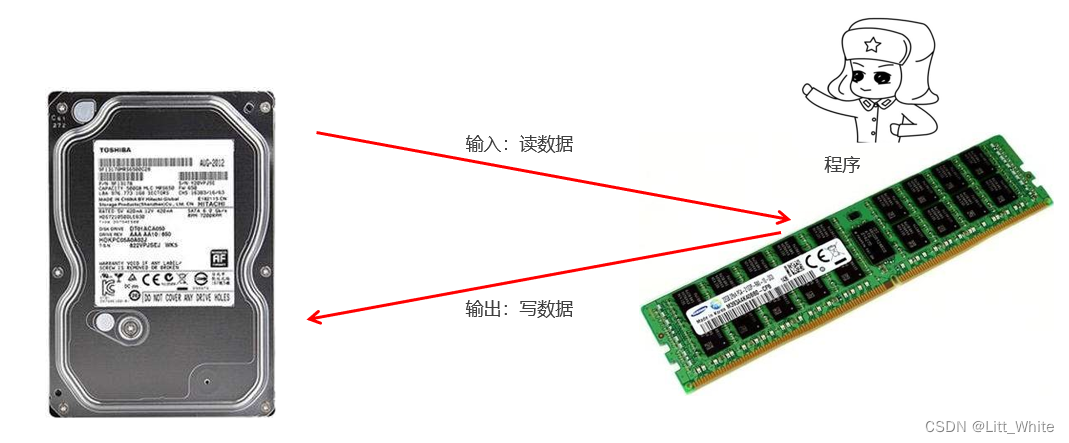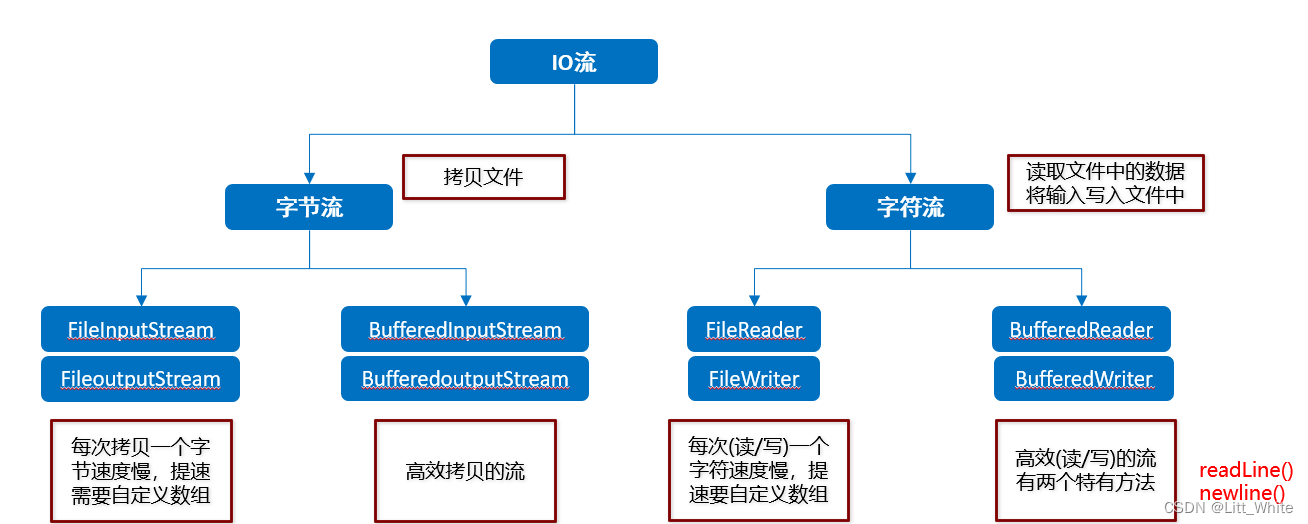18 File(18-19)
IO:对硬盘的文件进行读写
File:对(文件/文件夹)进行创建,删除等,表示要读写的(文件/文件夹)在哪
18.1 File构造方法
| 方法名 | 说明 |
|---|---|
| File(String pathname) | 通过将给定的路径名字符串转换为抽象路径名来创建新的 File实例 |
| File(String parent, String child) | 从父路径名字符串和子路径名字符串创建新的 File实例 |
| File(File parent, String child) | 从父抽象路径名和子路径名字符串创建新的 File实例 |
public static void main(String[] args) {
// 将字符串转换为抽象路径名来创建新的File实例
String path = "D:\\atest\\a.txt"; // D:\atest\a.txt
File file = new File(path);
System.out.println(file);
// 拼接两个字符串为一个抽象路径名
String path1 = "D:\\atest";
String path2 = "b.txt";
File file1 = new File(path1,path2);//把两个路径拼接.
System.out.println(file1);//D:\atest\b.txt
// 拼接 file + 字符串为一个抽象路径名
File file2 = new File("D:\\atest");
String path3 = "c.txt";
File file3 = new File(file2,path3);
System.out.println(file3); //D:\atest\c.txt
}
18.2 绝对路径和相对路径
绝对路径:从盘符开始
相对路径:相对当前项目下的路径
public static void main(String[] args) {
//这个路径固定不变了.
File file = new File("D:\\itheima\\a.txt");
//当前项目下的a.txt
File file2 = new File("a.txt");
//当前项目下 --- 指定模块下的 a.txt
File file3 = new File("filemodule\\a.txt");
}
18.3 File成员方法
创建文件/文件夹
| 方法名 | 说明 |
|---|---|
| public boolean createNewFile() | 创建一个新的空的文件 |
| public boolean mkdirs() | 创建一个单级/多级文件夹 |
public static void main(String[] args) throws IOException {
File file = new File("D:\\atest\\c.txt");
// createNewFile 注意:
// 1.文件夹路径必需存在,如果不存在,例如atest没有提前创建,就会报错
// 2.a.txt不存在,可以创建成功,返回true。如果已存在,创建失败,返回false(不光判断文件,还是跟文件夹名判断)
// 3.不管有没有后缀名,只能创建文件.不会创建文件夹。
// boolean res = file.createNewFile();
// System.out.println(res);
// mkdirs 注意点:
// 1.可以创建单级文件夹,也可以创建多级文件夹
// 2.不管调用者有没有后缀名,只能创建文件夹
// 3.如果文件名跟最后的路径名重复,也是会创建失败的,返回false。createNewFile也一样
boolean res2 = file.mkdirs();
System.out.println(res2);
}
删除文件/文件夹
| 方法名 | 说明 |
|---|---|
| public boolean delete() | 删除由此抽象路径名表示的文件或目录 |
public static void main(String[] args) {
//删除文件
File file = new File("D:\\atest\\a.txt");
boolean res = file.delete();
System.out.println(res);
// 删除空白文件夹
File file2 = new File("D:\\atest\\b");
boolean res2 = file2.delete();
System.out.println(res2);
// 删除带文件的文件夹
File file3 = new File("D:\\atest\\c");
boolean res3 = file3.delete(); // false
System.out.println(res3);
// 删除带空白文件夹的文件夹
File file4 = new File("D:\\atest\\c");
boolean res4 = file4.delete(); // false
System.out.println(res4);
}
判断和获取功能
| 方法名 | 说明 |
|---|---|
| public boolean isDirectory() | 测试此抽象路径名表示的File是否为目录 |
| public boolean isFile() | 测试此抽象路径名表示的File是否为文件 |
| public boolean exists() | 测试此抽象路径名表示的File(文件/文件夹)是否存在 |
| public String getAbsolutePath() | 返回此抽象路径名的绝对路径名字符串 |
| public String getPath() | 将此抽象路径名转换为路径名字符串 |
| public String getName() | 返回由此抽象路径名表示的文件(文件+后缀格式)或目录的名称 |
| public File[] listFiles() | 返回此抽象路径名表示的目录中的文件和目录的File对象数组 |
listFiles 方法注意事项
- 当调用者不存在时,返回null
- 当调用者是一个文件时,返回null
- 当调用者是一个空文件夹时,返回一个长度为0的数组
- 当调用者是一个有内容的文件夹时,将里面所有文件和文件夹的路径放在File数组中返回
- 当调用者是一个有隐藏文件的文件夹时,将里面所有文件和文件夹的路径放在File数组中返回,包含隐藏内容
- 当调用者是一个需要权限才能进入的文件夹时,返回null
public static void main(String[] args) {
File file = new File("D:\\atest");
File[] files = file.listFiles(); //返回值是一个File类型的数组
System.out.println(files.length);
for (File path : files) {
System.out.println(path);
}
}
18.4 实用方法
删除带文件的文件夹
public class Test2 {
public static void main(String[] args) {
//练习二:删除一个多级文件夹
//delete方法
//只能删除文件和空文件夹.
//如果现在要删除一个有内容的文件夹?
//先删掉这个文件夹里面所有的内容.
//最后再删除这个文件夹
File src = new File("C:\\Users\\apple\\Desktop\\src");
deleteDir(src);
}
private static void deleteDir(File src) {
//先删掉这个文件夹里面所有的内容.
//1.进入 --- 得到src文件夹里面所有内容的File对象.
File[] files = src.listFiles();
//2.遍历 --- 因为我想得到src文件夹里面每一个文件和文件夹的File对象.
for (File file : files) {
if(file.isFile()){
//3.判断 --- 如果遍历到的File对象是一个文件,那么直接删除
file.delete();
}else{
//4.判断
//递归
deleteDir(file);//参数一定要是src文件夹里面的文件夹File对象
}
}
//最后再删除这个文件夹
src.delete();
}
}
统计文件类型的个数
public class Test3 {
public static void main(String[] args) {
//统计一个文件夹中,每种文件出现的次数.
//统计 --- 定义一个变量用来统计. ---- 弊端:同时只能统计一种文件
//利用map集合进行数据统计,键 --- 文件后缀名 值 ---- 次数
File file = new File("filemodule"); // filemodule模块名
HashMap<String, Integer> hm = new HashMap<>();
getCount(hm, file);
System.out.println(hm);
}
private static void getCount(HashMap<String, Integer> hm, File file) {
File[] files = file.listFiles();
for (File f : files) {
if(f.isFile()){
String fileName = f.getName();
String[] fileNameArr = fileName.split("\\.");
if(fileNameArr.length == 2){
String fileEndName = fileNameArr[1];
if(hm.containsKey(fileEndName)){
//已经存在
//将已经出现的次数获取出来
Integer count = hm.get(fileEndName);
//这种文件又出现了一次.
count++;
//把已经出现的次数给覆盖掉.
hm.put(fileEndName,count);
}else{
//不存在
//表示当前文件是第一次出现
hm.put(fileEndName,1);
}
}
}else{
getCount(hm,f);
}
}
}
}
19 IO
19.1 概念
I 表示intput,是数据从硬盘进内存的过程,称之为读。
O 表示output,是数据从内存到硬盘的过程。称之为写。
所谓的读写,都是以内存为参照物,内存在读,内存在写。
io流读/写数据

读数据:内存读硬盘里的数据(输入流)
写数据:内存把数据写到硬盘中(输出流)
io流分类

19.2 字节流
1. 写数据
1.创建字节输出流对象
- 注意点:
如果文件不存在,会帮我们自动创建出来.
如果文件存在,会把文件清空.2.写数据
void write(int b):一次写一个字节数据void write(byte[] b):一次写一个字节数组数据void write(byte[] b, int off, int len):一次写一个字节数组的部分数据3.释放资源
public static void main(String[] args) throws IOException {
//1.创建字节输出流的对象 --- 告诉虚拟机我要往哪个文件中写数据了
// 第二个参数就是续写开关,如果没有传递,默认就是false,
// 如果第二个参数为true,表示打开续写功能,那么创建对象的这行代码不会清空文件.
FileOutputStream fos = new FileOutputStream("D:\\a.txt",true);
//FileOutputStream fos = new FileOutputStream(new File("D:\\a.txt")); // 两个效果一样
//2,写数据
// 这里的整数,实际写出的是整数在码表上对应的字母。
fos.write(97); // 写入的是字节数据
fos.write("\r\n".getBytes()); // 换行
byte [] bys = {97,98,99,100,101,102,103};
fos.write(bys,1,2); // 写入多个字节,可以传byte数组,也可以写多个值
//3,释放资源
fos.close();
}
字节流写数据的异常处理(try…catch…finally)
public static void main(String[] args) {
FileOutputStream fos = null;
try {
//System.out.println(2/0);
fos = new FileOutputStream("D:\\a.txt");
fos.write(97);
}catch(IOException e){
e.printStackTrace();
}finally {
//finally语句里面的代码,一定会被执行.
if(fos != null){
try {
fos.close();
} catch (IOException e) {
e.printStackTrace();
}
}
}
}
2. 读数据
1.创建字节输入流对象
- 注意点:
如果文件不存在,会直接报错.2.读数据
public int read():一次读取一个字节,返回值就是本次读到的那个字节数据.public int read(byte[] b):从输入流读取最多b.length个字节的数据3.释放资源
基本使用
public static void main(String[] args) throws IOException {
//如果文件存在,那么就不会报错.
//如果文件不存在,那么就直接报错.
FileInputStream fis = new FileInputStream("bytestream\\a.txt");
int read = fis.read();
//一次读取一个字节,返回值就是本次读到的那个字节数据.
//也就是字符在码表中对应的那个数字.
//如果我们想要看到的是字符数据,那么一定要强转成char
System.out.println((char)read);
//释放资源
fis.close();
}
读多个字节
public static void main(String[] args) throws IOException {
FileInputStream fis = new FileInputStream("bytestream\\a.txt");
//1,文件中多个字节我怎么办?
/*while(true){
int i1 = fis.read();
System.out.println(i1);
}*/
int b;
while ((b = fis.read())!=-1){
System.out.println((char) b);
}
fis.close();
}
复制功能
public static void main(String[] args) throws IOException {
//创建了字节输入流,准备读数据.
FileInputStream fis = new FileInputStream("C:\\itheima\\a.avi");
//创建了字节输出流,准备写数据.
FileOutputStream fos = new FileOutputStream("bytestream\\a.avi");
int b;
while((b = fis.read())!=-1){
fos.write(b);
}
fis.close();
fos.close();
}
提升复制速度的解决方案
public static void main(String[] args) throws IOException {
FileInputStream fis = new FileInputStream("C:\\itheima\\a.avi");
FileOutputStream fos = new FileOutputStream("bytestream\\a.avi");
byte [] bytes = new byte[1024];
int len; //本次读到的有效字节个数 -- 这次读了几个字节.
while((len = fis.read(bytes))!=-1){
fos.write(bytes,0,len);
}
fis.close();
fos.close();
}
19.3 字节缓冲流
主要是提升复制的效率
1. 复制数据(单个字节复制)
public static void method1() throws IOException {
BufferedInputStream bis = new BufferedInputStream(new FileInputStream("E:\\itcast\\字节流复制图片.avi"));
BufferedOutputStream bos = new BufferedOutputStream(new FileOutputStream("myByteStream\\字节流复制图片.avi"));
int by;
while ((by=bis.read())!=-1) {
bos.write(by);
}
bos.close();
bis.close();
}
2. 复制数据(字节数组复制)
public static void method2() throws IOException {
BufferedInputStream bis = new BufferedInputStream(new FileInputStream("E:\\itcast\\字节流复制图片.avi"));
BufferedOutputStream bos = new BufferedOutputStream(new FileOutputStream("myByteStream\\字节流复制图片.avi"));
byte[] bys = new byte[1024];
int len;
while ((len=bis.read(bys))!=-1) {
bos.write(bys,0,len);
}
bos.close();
bis.close();
}
19.4 字符流
1. 编码表
重点:
windows默认使用码表为:GBK,一个字符两个字节。
idea和以后工作默认使用Unicode的UTF-8编解码格式,一个中文三个字节。
2. 编码和解码方法
编码
| 方法 | 说明 |
|---|---|
| byte[] getBytes() | 使用平台的默认字符集将该 String编码为一系列字节,将结果存储到新的字节数组中 |
| byte[] getBytes(String charsetName) | 使用指定的字符集将该 String编码为一系列字节,将结果存储到新的字节数组中 |
解码
| 方法 | 说明 |
|---|---|
| String(byte[] bytes) | 通过使用平台的默认字符集解码指定的字节数组来构造新的 String |
| String(byte[] bytes, String charsetName) | 通过指定的字符集解码指定的字节数组来构造新的 String |
3. 字符流
字符流 = 字节流 + 编码表
不管是在哪张码表中,中文的第一个字节一定是负数。
4. 字节流,字符流使用
1、想要进行拷贝,一律使用字节流或者字节缓冲流
2、想要把文件中的数据读到内存中打印或运算,请使用字符输入流。
想要把集合,数组,键盘录入等数据写到文件中,请使用字符输出流
3、GBK码表一个中文两个字节,UTF-8编码格式一个中文3个字节。
5. 写数据
1.创建字符输出流对象
- 注意点:
如果文件不存在,会帮我们自动创建出来.但是要保证父级路径存在。
如果文件存在,会把文件清空.2.写数据
void write(int c) :一次写一个字符数据void write(char[] cbuf):一次写一个字符数组数据void write(char[] cbuf, int off, int len):一次写一个字符数组的部分数据void write(String str):一次写一个字符串,可以写中文void write(String str, int off, int len):一次写一个字符串的部分数据,可以写中文3.释放资源
flush():刷新流,还可以继续写数据。刷新流:相当于把内存此时的内容保存到硬盘中。close():关闭流,释放资源,但是在关闭之前会先刷新流。一旦关闭,就不能再写数据
public static void main(String[] args) throws IOException {
//创建字符输出流的对象
FileWriter fw = new FileWriter("charstream\\a.txt");
fw.write(97);
char [] chars = {98,99,100,101};
fw.write(chars);
fw.write(chars,0,3);
fw.write("黑马程序员abc");
//刷新流,把上面的内容先保存一份到硬盘中
fw.flush();
fw.write("黑马程序员abc",0,2);
//释放资源
fw.close();
}
6. 读数据
public static void main(String[] args) throws IOException {
//创建字符输入流的对象
// FileReader fr = new FileReader(new File("charstream\\a.txt"));
FileReader fr = new FileReader("charstream\\a.txt");
//读取数据
//一次读取一个字符
int ch;
while((ch = fr.read()) != -1){
System.out.println((char) ch);
}
//创建一个数组
char [] chars = new char[1024];
int len;
//read方法还是读取,但是是一次读取多个字符
//他把读到的字符都存入到chars数组。
//返回值:表示本次读到了多少个字符。
while((len = fr.read(chars))!=-1){
System.out.println(new String(chars,0,len));
}
//释放资源
fr.close();
}
19.5 字符缓冲流
1. 读数据
public static void main(String[] args) throws IOException {
//字符缓冲输入流
BufferedReader br = new BufferedReader(new FileReader("charstream\\a.txt"));
//读取数据
char [] chars = new char[1024];
int len;
while((len = br.read(chars)) != -1){
System.out.println(new String(chars,0,len));
}
br.close();
}
2. 写数据
public static void main(String[] args) throws IOException {
//字符缓冲输出流
BufferedWriter bw = new BufferedWriter(new FileWriter("charstream\\a.txt"));
//写出数据
//实际写出的是97对应的字符a
bw.write(97);
bw.write("\r\n");
//实际写出的是97 - 101 对应的字符 abcde
char [] chars = {97,98,99,100,101};
bw.write(chars);
bw.write("\r\n");
//实际写的是abc
bw.write(chars,0,3);
bw.write("\r\n");
//会把字符串的内容原样写出
bw.write("黑马程序员");
bw.write("\r\n");
//会把字符串的一部分写出 abcde
String line = "abcdefg";
bw.write(line,0,5);
bw.flush();
bw.close();
}
3. 字符缓冲流特有方法–newLine 跨平台的换行符
public static void main(String[] args) throws IOException {
//字符缓冲流的特有功能
//字符缓冲输出流BufferedWrite : newLine 跨平台的换行符
//创建对象
BufferedWriter bw = new BufferedWriter(new FileWriter("charstream\\a.txt"));
//写出数据
bw.write("黑马程序员666");
//跨平台的回车换行
bw.newLine();
bw.write("abcdef");
//跨平台的回车换行
bw.newLine();
bw.write("-------------");
//刷新流
bw.flush();
//释放资源
bw.close();
}
4. 字符缓冲流特有方法–readLine 读一整行
public static void main(String[] args) throws IOException {
//字符缓冲流的特有功能
//字符缓冲输入流BufferedReader: readLine 读一整行
//创建对象
BufferedReader br = new BufferedReader(new FileReader("charstream\\a.txt"));
//使用循环来进行改进
String line;
//可以读取一整行数据。一直读,读到回车换行为止。
//但是他不会读取回车换行符。
// readLine如果读不到数据返回null
while((line = br.readLine()) != null){
System.out.println(line);
}
//释放资源
br.close();
}
19.6 字节流和字符流小结

19.7 转换流

转换流就是来进行字节流和字符流之间转换的
- InputStreamReader是从字节流到字符流的桥梁
- OutputStreamWriter是从字符流到字节流的桥梁
public static void main(String[] args) throws IOException {
//method1();
//method2();
//在JDK11之后,字符流新推出了一个构造,也可以指定编码表
FileReader fr = new FileReader("C:\\Users\\apple\\Desktop\\a.txt", Charset.forName("gbk"));
int ch;
while ((ch = fr.read())!=-1){
System.out.println((char) ch);
}
fr.close();
}
private static void method2() throws IOException {
//如何解决乱码现象
//文件是什么码表,那么咱们就必须使用什么码表去读取.
//我们就要指定使用GBK码表去读取文件.
InputStreamReader isr = new InputStreamReader(new FileInputStream("C:\\Users\\apple\\Desktop\\a.txt"),"gbk");
int ch;
while((ch = isr.read())!=-1){
System.out.println((char) ch);
}
isr.close();
OutputStreamWriter osw = new OutputStreamWriter(new FileOutputStream("C:\\Users\\apple\\Desktop\\b.txt"),"UTF-8");
osw.write("我爱学习,谁也别打扰我");
osw.close();
}
//这个方法直接读取会产生乱码
//因为文件是GBK码表
//而idea默认的是UTF-8编码格式.
//所以两者不一致,导致乱码
private static void method1() throws IOException {
FileReader fr = new FileReader("C:\\Users\\apple\\Desktop\\a.txt");
int ch;
while ((ch = fr.read())!=-1){
System.out.println((char) ch);
}
fr.close();
}
19.8 对象操作流
可以把对象以字节的形式写到本地文件,直接打开文件,是读不懂的,需要再次用对象操作流读到内存中。
对象操作流分为两类:对象操作输入流和对象操作输出流
对象操作输出流(对象序列化流):就是将对象写到本地文件中,或者在网络中传输对象对象操作输入流(对象反序列化流):把写到本地文件中的对象读到内存中,或者接收网络中传输的对象
1. 读数据
public static void main(String[] args) throws IOException, ClassNotFoundException {
ObjectInputStream ois = new ObjectInputStream(new FileInputStream("a.txt"));
User o = (User) ois.readObject();
System.out.println(o);
ois.close();
}
2. 写数据
public static void main(String[] args) throws IOException {
User user = new User("zhangsan","qwer");
ObjectOutputStream oos = new ObjectOutputStream(new FileOutputStream("a.txt"));
oos.writeObject(user);
oos.close();
}
// 如果想要这个类的对象能被序列化,那么这个类必须要实现一个接口.Serializable
// User类
public class User implements Serializable {}
3. 注意:序列化对象后,修改了对象所属的JavaBean类
问题:此时会出问题,会抛出InvalidClassException异常.
解决:给对象所属的类加一个serialVersionUID
技巧:打开ArrayList源码,它也实现了Serializable 接口
public class User implements Serializable {
//serialVersionUID 序列号
//如果我们自己没有定义,那么虚拟机会根据类中的信息会自动的计算出一个序列号.
//问题:如果我们修改了类中的信息.那么虚拟机会再次计算出一个序列号.
//第一步:把User对象序列化到本地. --- -5824992206458892149
//第二步:修改了javabean类. 导致 --- 类中的序列号 4900133124572371851
//第三步:把文件中的对象读到内存. 本地中的序列号和类中的序列号不一致了.
//解决?
//不让虚拟机帮我们自动计算,我们自己手动给出.而且这个值不要变.
private static final long serialVersionUID = 1L;
// ...其他代码省略
}
4. 注意:成员不想序列化处理
给该成员变量加transient关键字修饰,该关键字标记的成员变量不参与序列化过程
public class User implements Serializable {
private static final long serialVersionUID = 1L;
private String username;
private transient String password;
}
5. 循环获取对象操作流
方式一
public static void main(String[] args) throws IOException, ClassNotFoundException {
Student s1 = new Student("杜子腾",16);
Student s2 = new Student("张三",23);
Student s3 = new Student("李四",24);
ObjectOutputStream oos = new ObjectOutputStream(new FileOutputStream("a.txt"));
oos.writeObject(s1);
oos.writeObject(s2);
oos.writeObject(s3);
oos.close();
ObjectInputStream ois = new ObjectInputStream(new FileInputStream("a.txt"));
Object obj;
// 对象操作流,不是null,也不是-1,而是一个异常错误
/* while((obj = ois.readObject()) != null){
System.out.println(obj);
}*/
while(true){
try {
Object o = ois.readObject();
System.out.println(o);
} catch (EOFException e) {
break;
}
}
ois.close();
}
方式二
public static void main(String[] args) throws IOException, ClassNotFoundException {
Student s1 = new Student("杜子腾",16);
Student s2 = new Student("张三",23);
Student s3 = new Student("李四",24);
ObjectOutputStream oos = new ObjectOutputStream(new FileOutputStream("a.txt"));
ArrayList<Student> list = new ArrayList<>();
list.add(s1);
list.add(s2);
list.add(s3);
//我们往本地文件中写的就是一个集合
oos.writeObject(list);
oos.close();
ObjectInputStream ois = new ObjectInputStream(new FileInputStream("a.txt"));
ArrayList<Student> list2 = (ArrayList<Student>) ois.readObject();
for (Student student : list2) {
System.out.println(student);
}
ois.close();
}
19.9 Properties
1. Properties概述
- 是一个Map体系的集合类
- Properties中有跟IO相关的方法
- 只存字符串
2. Properties集合的增删改查
public static void main(String[] args) {
Properties prop = new Properties();
//增
prop.put("小龙女","尹志平");
prop.put("郭襄","杨过");
prop.put("黄蓉","欧阳克");
System.out.println(prop);
//删
//prop.remove("郭襄");
//System.out.println(prop);
//改
//put --- 如果键不存在,那么就添加,如果键存在,那么就覆盖.
prop.put("小龙女","杨过");
System.out.println(prop);
//查
//Object value = prop.get("黄蓉");
//System.out.println(value);
//遍历
Set<Object> keys = prop.keySet();
for (Object key : keys) {
Object value = prop.get(key);
System.out.println(key + "=" + value);
}
System.out.println("========================");
//装的是所有的键值对对象.
Set<Map.Entry<Object, Object>> entries = prop.entrySet();
for (Map.Entry<Object, Object> entry : entries) {
Object key = entry.getKey();
Object value = entry.getValue();
System.out.println(key + "=" + value);
}
}
3. Properties集合的特有方法
public static void main(String[] args) {
//Object setProperty(String key, String value) --- put替代
//设置集合的键和值,都是String类型,底层调用 Hashtable方法 put
Properties prop = new Properties();
prop.setProperty("江苏","南京");
prop.setProperty("安徽","南京");
prop.setProperty("山东","济南");
System.out.println(prop);
//String getProperty(String key) --- get替代
//使用此属性列表中指定的键搜索属性
/* String value = prop.getProperty("江苏");
System.out.println(value);*/
//Set<String> stringPropertyNames() --- keySet替代
//从该属性列表中返回一个不可修改的键集,其中键及其对应的值是字符串
Set<String> keys = prop.stringPropertyNames();
for (String key : keys) {
String value = prop.getProperty(key);
System.out.println(key + "=" + value);
}
}
4. Properties集合与IO有关方法–load
public static void main(String[] args) throws IOException {
//void load(Reader reader) 将本地文件中的键值对数据读取到集合中
//void store(Writer writer, String comments) 将集合中的数据以键值对形式保存在本地
//读取
Properties prop = new Properties();
FileReader fr = new FileReader("prop.properties");
//调用完了load方法之后,文件中的键值对数据已经在集合中了.
prop.load(fr);
fr.close();
System.out.println(prop);
}
}
5. Properties集合与IO有关方法–store
public static void main(String[] args) throws IOException {
//void load(Reader reader) 将本地文件中的键值对数据读取到集合中
//void store(Writer writer, String comments) 将集合中的数据以键值对形式保存在本地
Properties prop = new Properties();
prop.put("zhangsan","123");
prop.put("lisi","456");
prop.put("wangwu","789");
FileWriter fw = new FileWriter("prop.properties");
prop.store(fw,null);
fw.close();
}





















 14万+
14万+











 被折叠的 条评论
为什么被折叠?
被折叠的 条评论
为什么被折叠?








